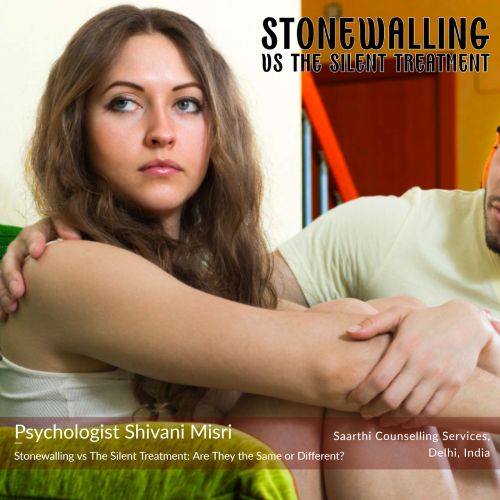Explains Leading Couples Therapist Shivani Sadhoo
In the sphere of interpersonal communication, conflicts, and disagreements are bound to happen. When faced with such situations, individuals or couples might resort to various coping mechanisms to protect themselves or express their emotions. Two commonly observed behaviours in conflicts are stonewalling and silent treatment.
While they might appear similar at first glance, there are vital distinctions between these two approaches. This article from Delhi’s leading marriage counsellor Shivani Misri Sadhoo aims to shed light on the differences between stonewalling and silent treatment, highlighting their effect on relationships and offering suggestions for healthier communication.

Shivani says, stonewalling refers to a defensive communication strategy where one partner becomes unresponsive and emotionally withdrawn during a conflict. It is mainly characterized by shutting down and refusing to engage in meaningful conversation. When a person stonewalls, they might avoid eye contact, provide short or monosyllabic responses, or physically stay away from the other person. The intention behind stonewalling is mostly to protect oneself from emotional distress or further escalation of the conflict.
On the other side, the silent treatment involves intentionally, ignoring or wilfully withholding communication as a kind of punishment or control. It is passive-aggressive behaviour intended to make the other partner feel excluded, rejected, or insignificant. Contrary to stonewalling, silent treatment is a conscious decision to ignore the other partner, mostly accompanied by a sense of superiority or power over them. It could be an incredibly hurtful experience for the recipient, as it leaves the person feeling isolated and frustrated.
Though both stonewalling and silent treatment involve a lack of communication, the underlying motivations and dynamics vary significantly. Stonewalling is mostly driven by a desire to self-protect and avoid conflict, whereas silent treatment is deeply rooted in manipulation, control, and punishment. Stonewalling individuals might feel overwhelmed by the intensity of the situation and opt to withdraw as a means of self-preservation. In contrast, those who use the silent treatment actively seek to exert power over their partner and gain control in the relationship.
The effect of stonewalling and silent treatment on relationships might be profound. Both behaviours stop healthy communication and prevent conflict resolution. Stonewalling could lead to a breakdown in emotional connection and trust between individuals. It makes a sense of emotional distance and disengagement, leaving the other partner feeling unheard and invalidated. Over time, repeated incidents of stonewalling will erode the foundation of a relationship, leading to resentment and further communication hardships.
Similarly, the silent treatment might be extremely damaging. It inflicts emotional pain on the recipient, creating feelings of rejection, worthlessness, and confusion. The lack of communication leaves the other partner guessing and desperately seeking a resolution, mostly resulting in heightened anxiety and tension. The silent treatment may foster a toxic dynamic where one person holds power over the other, leading to an unhealthy imbalance in the relationship.

Shivani Misri Sadhoo is an internationally recommended relationship Counsellor by world’s biggest and most trusted study and research-based foundation for couples therapy – Gottman Institute. She is trained on specialised key relationship counselling Skills from AIIMS, VIMHANS and various other reputed institutions. Counselor Shivani Misri Sadhoo, is also Certified for Emotionally Focused Therapy, Cognitive Behavioral Therapy and Dialectical Behaviour Therapy.
Counsellor Shivani Misri Sadhoo is also a Certified Neuro Linguistic Practitioner with specialised training and experience in the field of affairs/betrayals, trust issues, difficulty communicating, conflicting values, bereavement, grief and loss (affairs, separation, divorce, childhood) and emotional health issue (anxiety, social anxiety, fear, depression, low mood).
Currently, Shivani Misri Sadhoo is one of the top counsellors with the HIGHEST Success Rate with over 17,000 happy couples and individuals (based in India and abroad), who has benefited from her therapy. Psychologist and Counselor Shivani Misri Sadhoo not only practice independently from her clinic in Greater Kailash, Delhi, India but also listed on the panel of eminent hospitals like IBS Hospital – Institute of Brain & Spine, Express Clinic, Fortis (formerly) based in Delhi.



